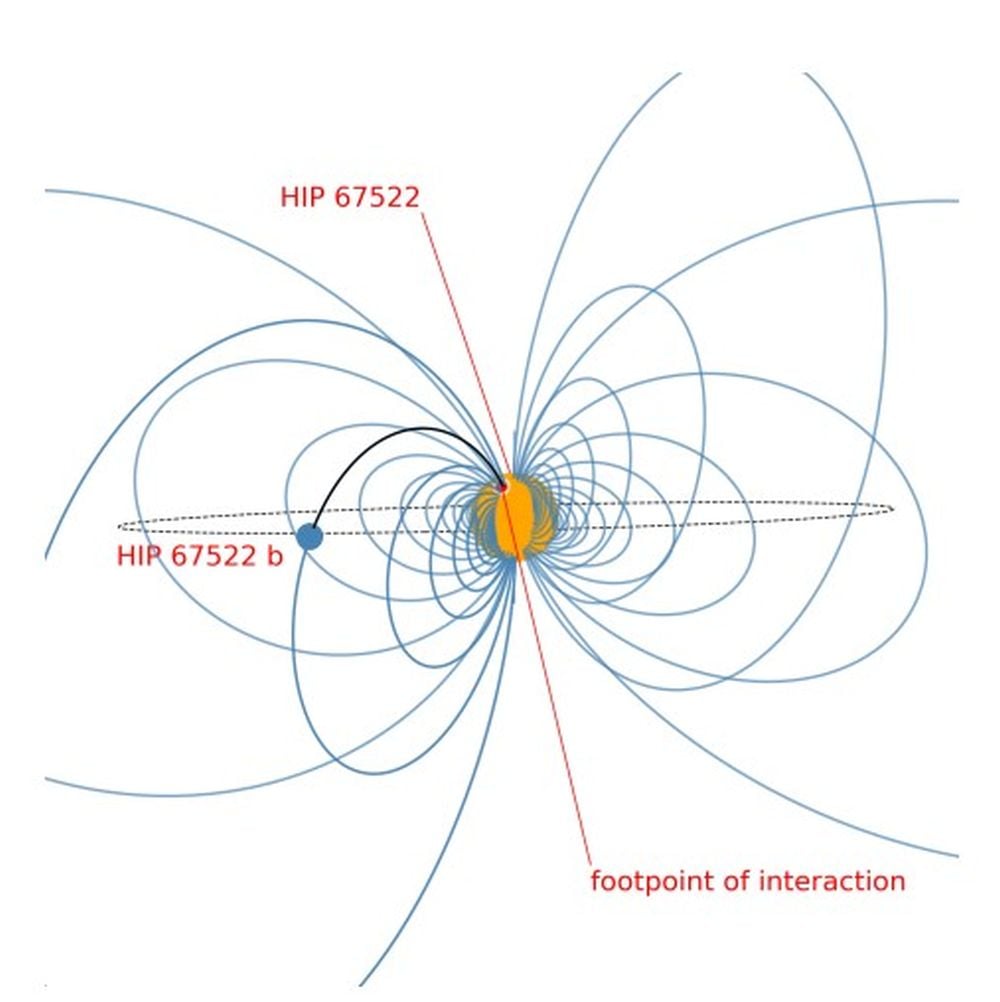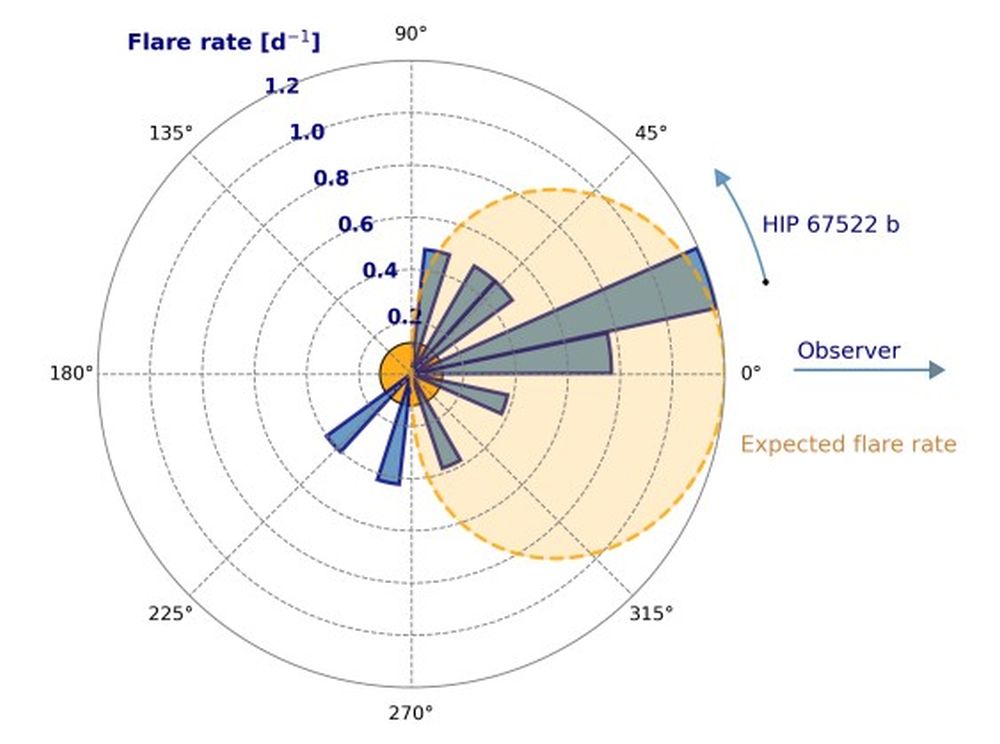Some exoplanets in their stars’ habitable zones may be distinctly uninhabitable due to solar flaring. Red dwarfs are known for powerful flaring, and since they’re dim and their habitable zones are close to the star, these flares could sterilize any planets and render them totally uninhabitable. But red dwarfs aren’t the only stars that flare; most do, including our Sun.
Astronomers have long thought that if a planet orbits close enough to its star, the planet could interfere with the star’s magnetic field and even trigger flares. Now, an international team of researchers have detected the first example of planet-induced stellar flaring on a Sun-like star about 400 light-years away. Their study is titled “Close-in planet induces flares on its host star,” and it’s been submitted to Nature for publication. The lead author is Ekaterina Ilin of the Netherlands Institute for Radio Astronomy.
Stars have extremely powerful magnetic fields that are fundamental to their nature. They’re generated by the conductive motion of plasma and the the dynamo effect. Stars’ magnetic field lines can become stressed and contorted, and when they settle down and suddenly reconnect, they can release enormously energetic stellar flares.
The star in the research is HIP 67522, a G-type main-sequence star like the Sun. It’s much younger than the 4.6 billion year old Sun, only about 17 million years old. There are two known exoplanets around the star: HIP 67522 b is the closest and follows an orbit only about 7 days long, while its sibling, HIP 67522 c, is a little further away and follows an approximately 14 day orbit. The study is focused on HIP 67522 b.
“So far, the search for magnetic star-planet interactions has remained inconclusive,” the authors write. “Here, we report the first detection of planet-induced flares on HIP 67522, a 17 million-year-old G dwarf star with two known close-in planets.”
The results are based on observations from the ESA’s CHEOPS mission and NASA’s TESS mission. These observations of HIP 67522 spanned five years and gave the researchers a long baseline with which to monitor the star. They detected 15 stellar flares during those observations. “We find that the 15 flares in HIP 67522 cluster near the innermost planet’s transit phase, indicating persistent magnetic star-planet interaction in the system. The stability of interaction implies that the innermost planet is continuously self-inflicting a six time higher flare rate than it would experience without interaction,” the authors write.
The JWST has observed HIP 67522 b and detected a surprising extended atmosphere that will likely be stripped away over time. Ilin and her co-authors of the new research say that the flaring from the star could be responsible. “HIP 67522 is therefore an archetype to understand the impact of magnetic star-planet interaction on the atmospheres of nascent exoplanets,” they write.
HIP 67522 b has about 14 Earth masses. It’s one of the youngest transiting exoplanets ever found. It’s also one of the least dense. It orbits at less than 12 stellar radii away from the star. That means it’s likely in the sub-Alfvenic regime, where the solar plasma from the star is slow enough that the star’s magnetic waves can travel upstream against the flow. That means that Alfven waves can influence the interaction between the plasma flow and any objects it encounters, in this case the exoplanet HIP 67522 b.
“In this regime, perturbations of the stellar magnetic field induced by the planet can travel back to the star along the magnetic field lines that tether the two bodies,” the researchers explain.
 This figure from the research shows how HIP 67522 b induces flaring in the star. The exoplanet perturbs the star’s inclined magnetic field toward the surface of the star. It triggers flares at the footpoint which is only periodically visible to the observer. Image Credit: Ilin et al. 2025.
This figure from the research shows how HIP 67522 b induces flaring in the star. The exoplanet perturbs the star’s inclined magnetic field toward the surface of the star. It triggers flares at the footpoint which is only periodically visible to the observer. Image Credit: Ilin et al. 2025.
Of the 15 flares observed, most of them are related to the exoplanet’s closest approach to the star. “The flare rate is highly elevated shortly after transit: we detect
11 flares in the orbital phase range 0–0.2 and only 4 flares throughout the rest of the orbit, amounting to an almost nine times higher flare rate in the 0–0.2 phase
range,” the researchers explain.
 This figure shows the flares relative to the orbit of the exoplanet. “HIP 67522 showed a significant increase in flare rate in the expected range, indicating that the majority of detected flares were triggered by the planet,” the researchers write. “Planet-induced flares can only be seen when the planet faces the observer (±90◦), and most flares can be expected near the transit of HIP 67522 b (0◦). Image Credit: Ilin et al. 2025.
This figure shows the flares relative to the orbit of the exoplanet. “HIP 67522 showed a significant increase in flare rate in the expected range, indicating that the majority of detected flares were triggered by the planet,” the researchers write. “Planet-induced flares can only be seen when the planet faces the observer (±90◦), and most flares can be expected near the transit of HIP 67522 b (0◦). Image Credit: Ilin et al. 2025.
There are still many details to be worked out before scientists understand exactly how the planet-induced stellar flaring works. The authors think that energy stored in coronal loops plays a role. These loops are arch-like structures in a star’s atmosphere that contain dense plasma. They’re magnetically isolated from their surroundings. “We therefore suggest that the power in planet-induced flares in HIP 67522 is supplied by the energy reservoir stored in the star’s coronal loops, with the star–planet interaction being a flare triggering mechanism,” the authors explain.
“Regardless of the underlying mechanism, the observed planet-induced emission has striking consequences,” the authors write. “The orbital phases of the flares induced by HIP 67522 b imply that the interaction with the star backfires on the planet through self-inflicted space weather.”
The flares from HIP 67522 affect the planet in deleterious ways, but not at first. At this young age, the flares are heating up HIP 67522 b’s atmosphere and causing it to expand. This inflation means that while the exoplanet is comparable in size to Jupiter, it’s only about 5% of its mass. But over time, the flares will strip away the atmosphere. In about 100 million years, the planet could shrink down and become a hot-Neptune, a common type of exoplanet.
“Our results establish HIP 67522 as the archetype system for flaring star-planet interaction” the researchers write. According to them, this is the first star-planet system where their interactions lasted and were observed for at least three years. “The reliability of our detection opens the door to follow-up observations, and urges the characterization of HIP 67522 c to allow for differential analysis of the two planets in the system.”
With these results in hand, the researchers say they’re poised to observe other systems that are likely candidates for exoplanet-induced flaring.
“Planetary space weather and magnetic fields are crucial for understanding their atmospheric dynamics, assessing habitability, and probing interior compositions – key to unraveling how planets throughout the Milky Way, including those in our Solar System, have formed and evolved,” the authors conclude.


